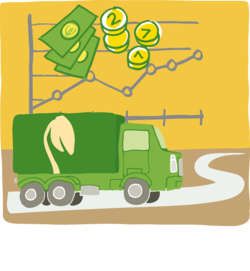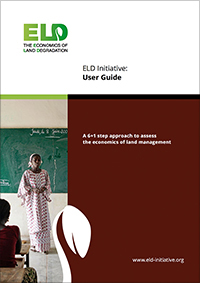ELD 6+1 Step Approach to assess the economics of land management
Six steps drawing from a collection of methodologies to establish a cost-benefit analysis of possible actions, plus one step to take action.
The 6+1 step approach is the analysis method that has been adopted by the ELD Initiative to guide users through the process of establishing scientifically sound cost-benefit analyses to inform decision-making processes.
Listed below a summary of each step and the aspect of the process it targets:

1
Inception
Identification of the scope, location, spatial scale, and strategic focus of the study, based on stakeholder consultation. Preparation of background materials on the socio-economic and environmental context of the assessment.
Methods for:
stakeholder participation (consultation, engagement); systematic review and synthesis of academic and grey literature; selection of relevant existing case studies; extrapolation of existing case studies for global comparison; collection of background socio-economic and environmental data; policy analysis.

2
Geographical characteristics
Establishment of the geographic and ecological boundaries of the study area identified in Step 1, following an assessment of quantity, spatial distribution, and ecological characteristics of land cover types that are categorised into agro-ecological zones and analysed through a Geographical Information System (GIS).
Methods for:
stakeholder participation (consultation, engagement); definition and mapping of land covers and agro-ecological zones from the sciences (physical geography, ecology, soil sciences, landscape sciences, etc.).

3
Types of ecosystem services
For each land cover category identified in Step 2, identification and analysis of stocks and flows of ecosystem services for classification along the four categories of the ecosystem service framework. The four categories are:
- Provisioning services are the goods or products obtained from ecosystems, such as food, timber, medicines, fibres and freshwater
- Regulating services are the benefits obtained from an ecosystem’s control of natural processes such as climate regulation, disease control, erosion prevention, water flow regulation and protection from natural hazards
- Cultural services are the nonmaterial benefits obtained from ecosystems such as recreation, spiritual values and aesthetic enjoyment
- Supporting services are the natural processes such as soil formation, nutrient cycling and primary productivity that maintain other ecosystem services
Methods for:
stakeholder participation (consultation, engagement); identifying different ecosystem stocks and flows (from ecology); categorising ecosystem services into the four categories of the ecosystem service framework.

4
Roles of ecosystem services and economic valuation
Establishment of the link between the role of ecosystem services in the livelihoods of communities living in each land cover area and in overall economic development in the study zone. Estimation of the total economic value for each ecosystem service.
Methods for:
stakeholder participation (consultation, engagement); identification of available economic data from relevant case studies; data collection and surveys; multi-criteria analyses to identify important ecosystem services; valuation methods for estimation of “missing” economic values (no market price); extrapolation of case studies for global comparison.

5
Patterns and pressures
Identification of land degradation patterns and drivers, pressures on sustainable management of land resources and drivers of adoption of sustainable land management (including determining the role of property rights and legal systems), and their spatial distribution to inform the establishment of global scenarios. Revision of previous steps if needed, to ensure the assessment is as comprehensive as possible.
Methods for:
stakeholder participation (consultation, engagement); identification of types of land degradation, patterns, and pressures (from soil sciences, ecology, agricultural sciences, physical geography, etc.); mapping methods (GIS); establishment of global scenarios.

6
Cost-benefit analysis and decision making
Cost-benefit analysis (CBA) comparing costs and benefits of an ‘action’ scenario to that of a ‘business-as-usual’ scenario to assess whether the proposed land manage¬ment changes lead to net benefits. (‘Action’ scenarios include land management changes that can reduce or remove degradation pressures). Mapping of net benefits for identification of the locations for which land management changes are suitable from an economic perspective. This will lead to the identification of “on-the-ground” actions that are economically desirable.
Methods for:
stakeholder participation (consultation, engagement); cost benefit analysis with participatory establishment of action scenario and business as usual scenario, choice of discount rate, computation of indicators of economic viability; mapping methods (GIS); estimation of shadow interest rates.
Tools to facilitate the building of cost-benefit analyses (micro-economic level):
Toolkit for Ecosystem Service at Site-based Assessment (TESSA); Assessment and Research Infrastructure for Ecosystem Services (ARIES); Corporate Ecosystem Services Review (ESR); Integrated Valuation of Ecosystem Services and Tradeoffs (InVEST); Multi-scale Integrated Models of Ecosystem Services (MIMES); Natura 2000, etc.
+
+1 Step: Take action!
Land users: implement the most economically desirable ‘on the ground’ option(s) by changing land management practices or land use, at multiple scales and levels.
Methods for:
stakeholder participation (consultation, outreach, awareness raising, engagement).
Private sector: engage in discussions with stakeholders from all sectors directly impacted by changes in ecosystem services to reduce risks associated with a weaker link in the value chain and increasing opportunities for investment in sustainable land management. This requires relevant and suitable impact pathways to be identified, to promote and facilitate actions that can be scaled up and out.
Methods for:
stakeholder participation in relation to corporate social responsibility (consultation, outreach, awareness raising, engagement), land materiality screening toolkit, value chain analysis.
Policy-/decision makers:
facilitate adoption of most economically desirable option(s) on the ground by adapting the legal, policy, institutional and economic contexts at multiple scales and levels. This requires relevant and suitable impact pathways to be identified, to promote and facilitate actions that can be scaled up and out.
Methods for:
stakeholder participation (consultation, engagement); identification and social construction of impact pathways (e.g., multi-criteria analyses that identify preferences over possible impact pathways).
Tools at the macro-economic level:
Natural Capital Accounting using, for example, the UN System of Environmental-Economic Accounting (SEEA) or other wealth accounting approaches.

